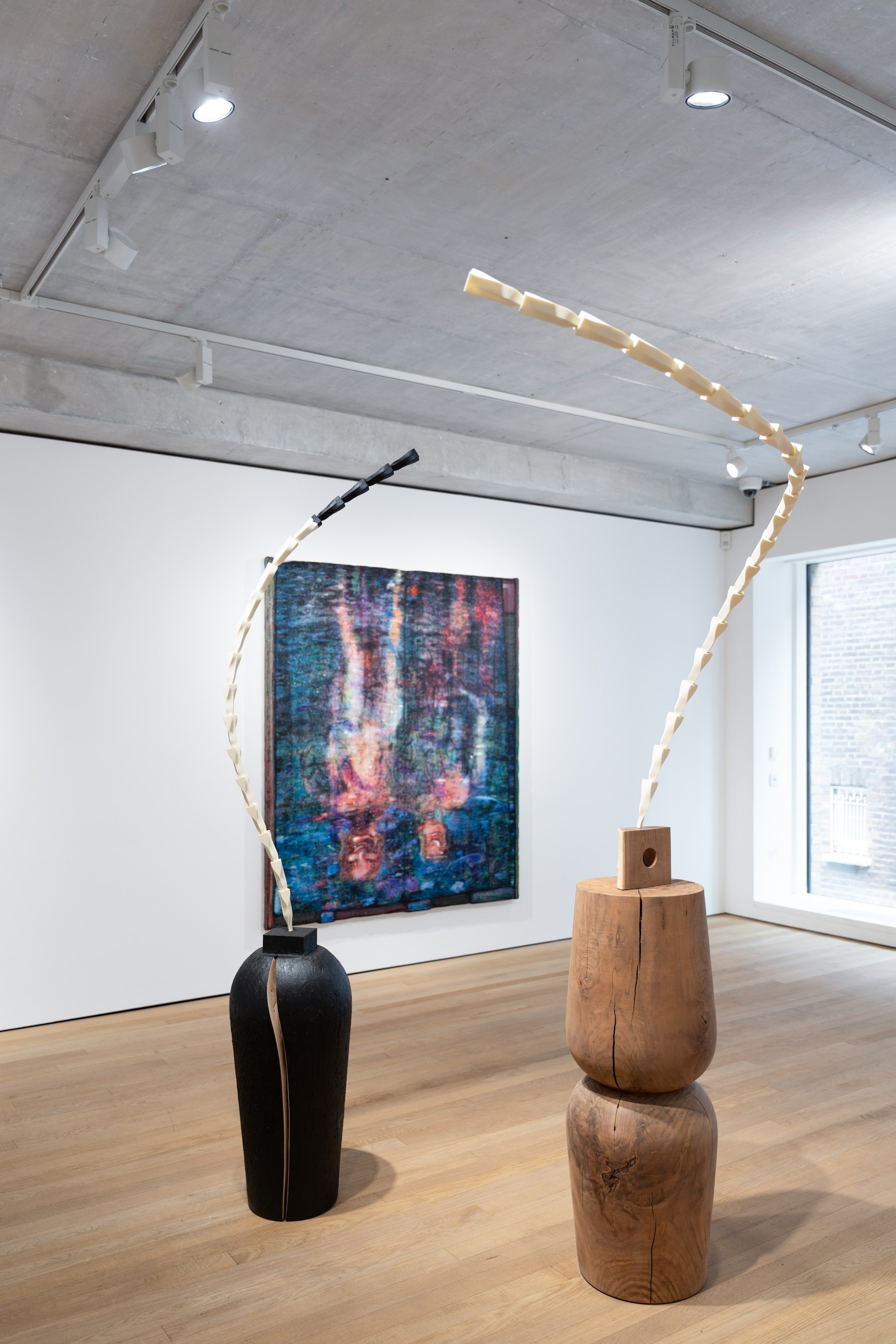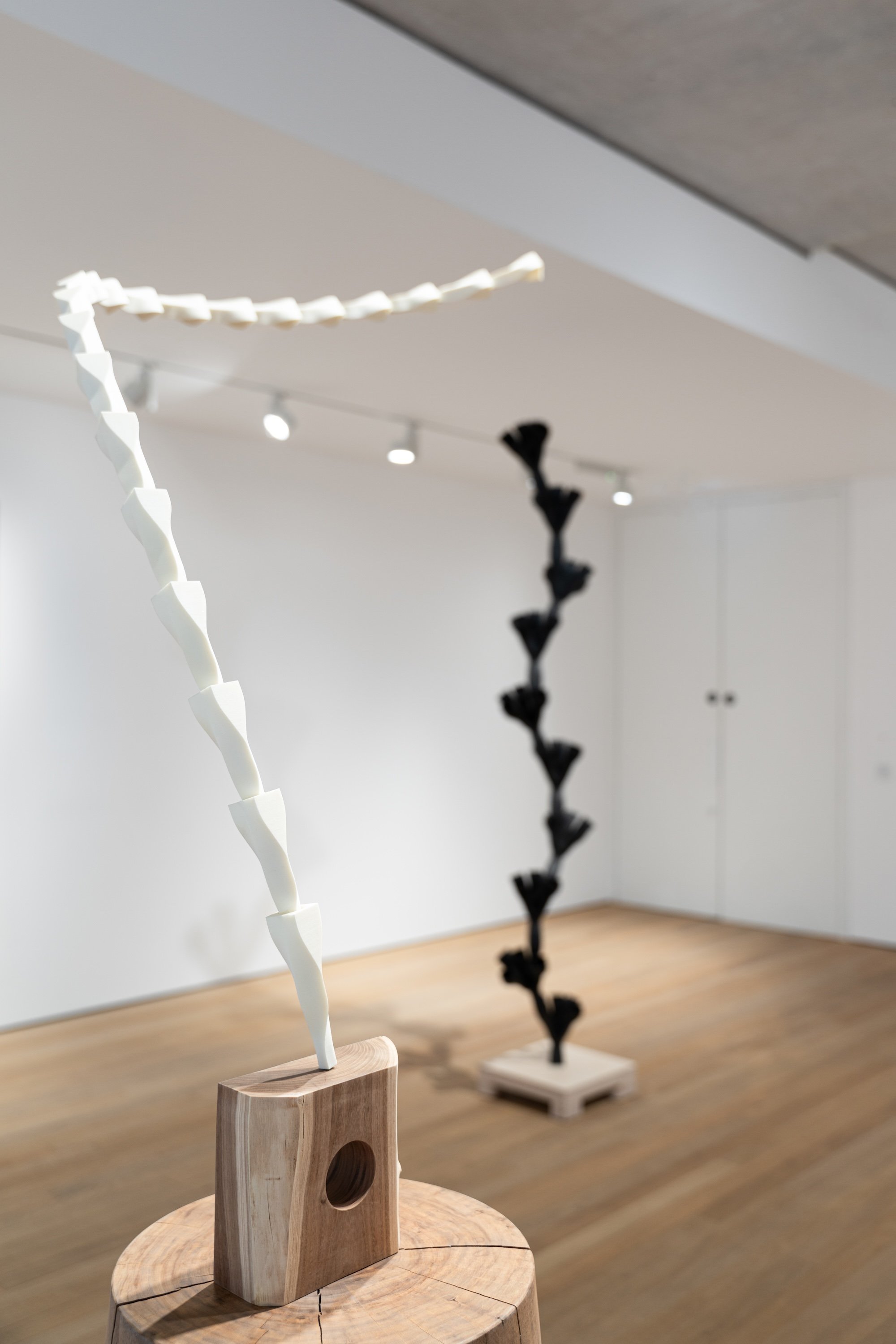FRIEZE NO. 9 CORK ST | LONDON
OPENING MAY 2 | 6PM—8PM
ON VIEW MAY 3 TO MAY 18, 2024
GALLERY HOURS TUESDAY – SATURDAY, 10AM—6PM
CARVALHO PARK’s inaugural participation with Frieze No. 9 Cork Street in London simultaneously marks the gallery’s first exhibition in the United Kingdom. Featuring Kristian Touborg (Copenhagen), Se Yoon Park (New York and Seoul), and Yulia Iosilzon (London), the presentation exemplifies the artists’ cross-disciplinary practices, engaging sculpture, painting, assemblage, and collage, to court the eternal processes of growth and decay that underlie our world. What are the physical sensations, processes, energies, and emotions that characterize such flux? Touborg, Park, and Iosilzon each offer ways of thinking about life and its renewal. Park’s sculptures reckon with rhizomatic structures, while Iosilzon’s and Touborg’s paintings build worlds in which fluidity reigns.
Formally, Park’s works propose the rhizome, a root-like form defined by inner endlessness and principles of connection. Park’s Continuum sculptures are pendant portraits that stress the eternal becoming of the selves, but also offer poignant insights to distinct personalities, fusing the geometric with the autobiographical. The component parts of Continuum: Self-portrait (true reflection of the father) coalesce to a dramatic, elongated arc. Continuum: Motherconversely reaches out, its wingspan tenderly enfolding the air, radiating a light synonymous with gentleness and care. Park establishes harmony in this opposing dualism – strength and rootedness to weightless flow. Each unit comprising the total is Park’s self-portrait geometry, Light and Darkness Type A. When illuminated by one light source, its symmetries effectuate a telling equilibrium: 70% harnesses light, 30% is cast in shadow. Repetition and mirroring formally trace the artist’s pursuit to find himself through himself. Non-figurative representation allows Park lucid access to the flicker of personalities, the depths of feeling. Two people become distinct but interrelated, ovoid pedestals sprouting long, linear forms, as though Park’s gaze had penetrated beneath the flesh to the molecular structure beneath.
The laboratory of the self, in Park’s work, are dreams. Dream III consists of hundreds of self-portrait sculptures, colorful geometric nodes that allude to the foundation of self-expression — the letter ‘I’ — in a suspended translucent sphere. Accumulated over time, and evocative of an open-ended process, the series captures the nature of dreaming and becoming, alike as rhizomatic experiences without a beginning, conclusion, or center. Infusing a precise geometric vocabulary with the tangible warmth of shared human experience, his dreams, as self-portraits, incite a familiar current.
Iosilzon’s paintings share Park’s interest in alternative figurations of the self. Her environments are inhabited by dynamic, changing entities with hybrid anatomies that mix delicately featured human faces with bulbous animal bodies. These creatures move through a colorfully flecked, luminous matter that supports and harmonizes their existence, like an extracorporeal amniotic fluid. They are weightless, powerfully redolent not just of freedom, but of joy. Iosilzon’s figures radiate a sense of possibility and suggest new affinities and forms of enmeshment between humans, animals, and their environment. The exuberant, whimsical world Iosilzon builds might appear fantastical, but it acknowledges a real co-existence between different forms of life, visualizing our dependence on one another as organisms through an intermingling of body parts. Iosilzon playfully meditates on our indebtedness to and immersion within nature’s systems by expanding the definitional bounds of the human, adding a crustacean claw and an equine leg, a pair of horns or hooves.
Cross-pollinations, mutations, and interconnectedness are conveyed in Iosilzon’s work through metaphors of free-fall motion. Or, as the title of Touborg’s painting imagines a similar state, through Floating. Here a blurred, almost hybridized figure is suspended against a rippling surface of water suffused with iridescent light. She is not plummeting or struggling to the surface of an inhospitable substance: as for Iosilzon’s creatures, Touborg’s figure is held by her environment – a liquid that is both void and a mirror of bright, unsettling reflections. The woman’s wholeness and monumental presence is contrasted with a pair of androgynous, shadowy figures in rorriM niwT (the phrase ‘Twin Mirror’ written in reverse so it might be read through a mirror). One figure is seen alongside a more submerged twin, fragments of themselves coruscating across the water’s rippling surface, narrating the duality of self and the subconscious. Touborg’s oscillation between vibrancy and darkness, echoes a mood of excitement and anxiety, the charged paradox of experiencing beauty intertwined with the nightmare. Here are the profound effects of personal experiences refracted through universal themes of identity, inversion, and the fluid boundaries of the self.
These paintings are preoccupied with impermanence and how representation might convey the instability of consciousness and the phenomenal world. Summer Night Plasticity (Excessive Impressionism) III suggests multiple ways through this potential impasse. Wet paint has been vacuum packed and stitched onto the work’s surface, preserving a reminder of the subject matter and medium’s fluidity on the finished canvas. Through the incorporation of wooden nodes and lengths of recycled polyester, Touborg gives his paintings a physical, sculptural presence. Paintings are composed of canvases visibly sewn together, a self-conscious gesture of rupture and repair that foregrounds process, the painting’s constructedness. These techniques together suggest a physical quality to perception, an entwining of sight and touch.
Park’s sculptures amount to their own archive of fleeting moments. Works such as Dream III address the everyday, chronicling Park’s moods through an idiosyncratic yet evocative form of color symbolism. Park’s scale is private, while Iosilzon’s is mythic, biblical. Her charged, liquid landscapes reference and transform flood narratives found across cultures. Rather than focus on devastation or divine retribution, Iosilzon explores the possibilities of a changed world, somewhere we might learn to live together differently. Bringing Iosilzon, Park, and Touborg into conversation reveals these artists’ complementary renderings of the self and its net of interconnections, their joint affirmation of alternative ways of growing outwards and floating onwards.
Text by Dr. Rebecca Birrell, Leverhulme Trust Fellow, The University of St Andrews
Kristian Touborg (b.1987 in Roskilde, Denmark) holds a Masters from the Royal Danish Academy of Fine Arts. Recent exhibitions include Merged Echoes, CARVALHO PARK, New York (2023–24, two-person); Vibrant Escape: Ode to Summer, WOAW Gallery, Hong Kong (2023); Dandelion, Newchild, Antwerp (2023, solo); Fluttering The Void, Berlinskej Model, Prague (2022, solo); Trust in Mortals, Brigade Gallery, Copenhagen (2022); Light Blue Noise, Lundgren Gallery, Palma de Mallorca, Spain (2022, solo); Peripheries, Newchild, Antwerp (2022); Bright Beneath, Eduardo Secci, Novo Projects, Milan (2021, solo); As We Turn Fluent, CARVALHO PARK, New York (2021, two-person); and Soft, Metal, Factory — HEART Collection, Herning Art Museum, Denmark (2021). The artist presented his first institutional solo exhibition in 2022 at Kunsthal Kongegaarden. His work is included in the permanent collections of HEART Herning Museum of Contemporary Art, Randers Kunstmuseum; Nixon Collection; The Blake Byrne Collection; and Statens Kunstfond. Touborg lives and works in Copenhagen.
Se Yoon Park 박세윤 (b. 1979, South Korea) is a sculptor living and working in New York and Seoul. Park’s foundation in architecture reverberates through the deft construction of his geometries in his sculptural installations. Integral to his perspective is the deconstructivist approach of Dutch architect Rem Koolhaas, founder of Office for Metropolitan Architecture (OMA), Netherlands, where Park began his career as an architect. Park conducted his undergraduate studies in architecture at the department of Architectural Engineering at Yonsei University in Seoul, and holds a Master of Architecture from Columbia University, New York. In addition to his time at OMA, his work in the realm of architecture includes Bjarke Ingels Group, Fernando Romero Enterprise, and Joshua Ramus. Park began his exploration of light and shadow in his own work as a sculptor in 2014. His work has since been shown at Palazzo Mora in Venice, in tandem with the 57th Venice Biennale, at the United Nations in the 13th UNCCD exhibition, and in solo and two-person exhibitions in New York, Seoul, and Miami, with CARVALHO PARK (New York), Gallery Mark (Seoul), and Huue Contemporary (Seoul, Singapore), and as public art commissions in South Korea.
Yulia Iosilzon (b. 1992, Moscow) lives and works in London. She holds a MA in Fine Art from the Royal College of Art, London (2019) and a BA in Fine Art from the Slade School of Art, London (2017). Solo exhibitions include Modus Operandi (2024) at Berntson Bhattacharjee, London; Heaven’s Chambers (2023), A Chorus of Beauty and Menace (2021), and Paradeisos (2019) at CARVALHO PARK, New York; Nocturnal (2022) with Foundry, Seoul; Amanita Muscaria (2022) with De Brock Gallery, Antwerp; Frogspawn (2022) at Sapling, London; Fanfarria (2021) at Huxley-Parlour, London; and The Big Fish! (2021) with Berntson Bhattacharjee, in collaboration with Sotheby’s Scandinavia, Stockholm. Iosilzon’s work has been shown in group exhibitions at Galerie Pangée, Montréal; Tabula Rasa Gallery, Beijing; De Brock Gallery, Knokke; Berntson Bhattacharjee, London; SpaceK, Seoul; and Moscow Museum of Contemporary Art, Moscow; among others. Institutional acquisitions include the Roberts Institute of Art; Xiao Foundation Museum; X Museum; and Sixi Museum. Iosilzon is the recipient of the Bloomberg New Contemporaries Prize, the Audrey Wykenham Prize, and has been shortlisted for the Hix Award. She is featured in the forthcoming Anomie Review of Contemporary British Painting, Vol. III.




















